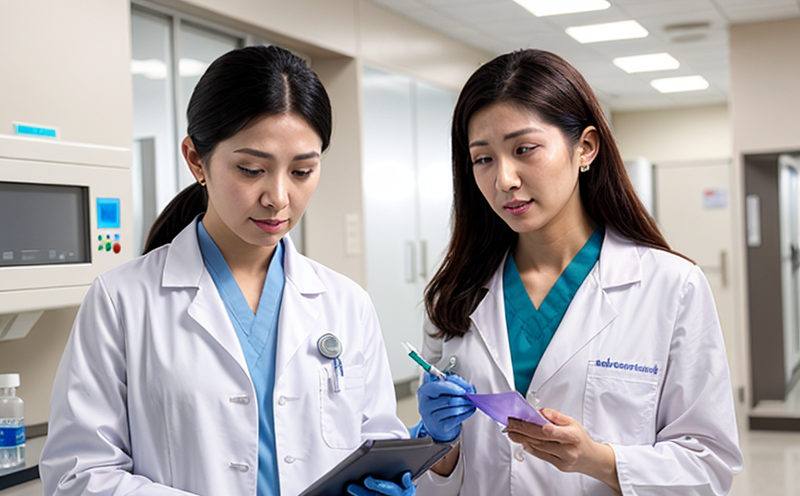ICH Q5E Comparability of Biotechnological Products Testing
The International Conference on Harmonisation (ICH) Guideline Q5E provides a framework for ensuring the comparability of biotechnological products. This guideline is crucial in the pharmaceutical industry, especially when dealing with biosimilars and biopharmaceuticals where slight differences in manufacturing processes can significantly impact product efficacy and safety.
The ICH Q5E Testing primarily focuses on demonstrating that a biosimilar product is comparable to an innovator/reference product. This involves thorough characterization of the product, process understanding, and ensuring consistent quality through various stages of production. The testing protocol aims at identifying potential differences in critical quality attributes (CQAs) such as protein structure, post-translational modifications, glycosylation patterns, and stability profiles.
The comparability exercise under ICH Q5E involves multiple phases including:
- Initial characterization of both the innovator product and the biosimilar candidate
- Process development studies to understand the manufacturing process for each product
- Demonstration that the two products have similar physicochemical properties
- Pharmacological and toxicological testing to ensure safety equivalence
The comparability exercise is not just about confirming similarities in test results; it's also a process of understanding how these products behave under various conditions. This includes stability testing, long-term storage studies, and accelerated stress tests. The goal is to predict the behavior of the biosimilar product over its shelf life by comparing it with the innovator.
Given the complexity of biotechnological products, ICH Q5E requires a multidisciplinary approach involving experts from various fields such as biochemistry, molecular biology, and analytical chemistry. The laboratory must possess state-of-the-art instrumentation capable of handling complex biological samples. Common instruments used include high-performance liquid chromatography (HPLC), mass spectrometry (MS/MS), and nuclear magnetic resonance spectroscopy (NMR).
The comparability exercise is a critical phase in the development lifecycle of biosimilars. It ensures that healthcare providers have access to reliable, safe, and effective medicines. The testing process itself can be labor-intensive and time-consuming, requiring strict adherence to protocols to ensure accurate results.
| Test Stage | Main Focus | Instruments Used |
|---|---|---|
| Initial Characterization | Detailed analysis of the protein structure and post-translational modifications. | HPLC, MS/MS, NMR |
| Process Understanding | Understanding how manufacturing processes impact product quality. | Data Analysis Software, Statistical Process Control Tools |
| Pharmacological Testing | Evaluation of the biological activity and safety of the biosimilar. | In vivo and in vitro testing platforms |
Industry Applications
The ICH Q5E comparability exercise is widely applied across the pharmaceutical sector, particularly within biopharmaceutical and biosimilar development. The following applications highlight its importance:
- Biosimilar Development: Demonstrating that a biosimilar product is equivalent to an innovator product.
- New Drug Approval: Supporting the regulatory approval process by ensuring consistent quality across batches and manufacturing sites.
- Cross-Batch Comparability: Ensuring that products from different production lots are comparable, especially when scaling up or changing manufacturing facilities.
The comparability exercise is not only a regulatory requirement but also an essential tool for maintaining the trust of healthcare providers and patients. By ensuring consistent quality, ICH Q5E helps mitigate risks associated with changes in production processes or suppliers.
Quality and Reliability Assurance
The reliability and accuracy of comparability testing are paramount for the pharmaceutical industry. The laboratory must adhere to stringent quality assurance (QA) protocols to ensure that all tests meet international standards such as ICH Q5E, ISO 17025, and other relevant guidelines.
Quality control measures include:
- Dedicated clean rooms for sample preparation
- Calibration of instruments before each use
- Regular maintenance and validation of test methods
- Data integrity and traceability throughout the testing process
The laboratory must also ensure that all personnel involved in the testing are trained to the highest standards. This includes proficiency in handling complex biological samples, using advanced analytical instruments, and interpreting results accurately.
In conclusion, quality assurance is not just a compliance requirement; it’s an integral part of ensuring patient safety and satisfaction. By adhering to strict QA protocols, laboratories can provide reliable data that supports the development and approval of safe and effective biotechnological products.
Use Cases and Application Examples
The ICH Q5E comparability exercise is applied in several real-world scenarios:
- Biosimilar Approval: Demonstrating that a biosimilar product is comparable to its reference innovator.
- Manufacturing Process Optimization: Ensuring consistency between different manufacturing batches by comparing their physicochemical properties.
- Cross-Batch Quality Control: Monitoring the quality of products from different production lots using comparability tests.
A case in point is the development of a biosimilar to a reference product. The process involves thorough characterization, process understanding, and extensive testing to demonstrate that the biosimilar has the same CQAs as the innovator. This ensures that healthcare providers can confidently prescribe these products without concerns about efficacy or safety.





